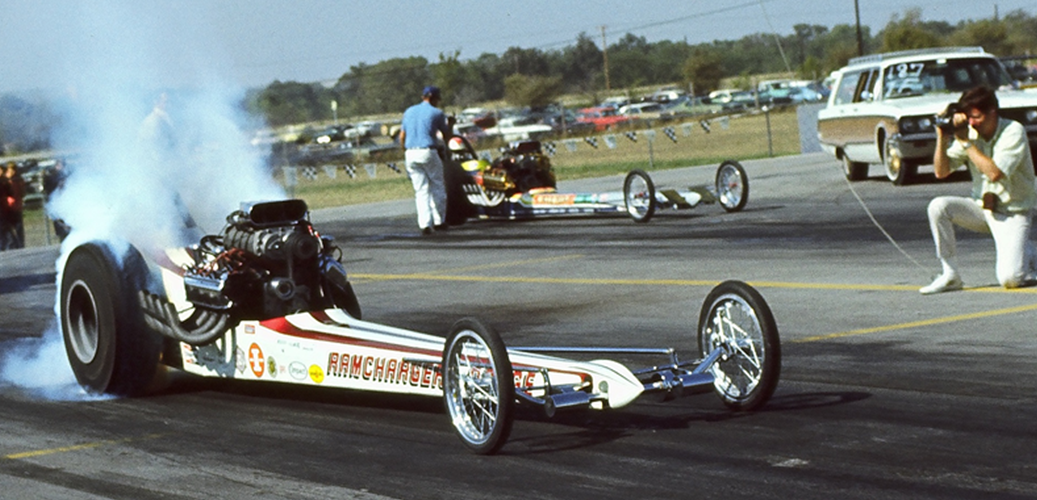The Elephant in the Room
The Racing Success of the 426 HEMI® Engine
In 1964, the world of Mopar® and motorsports changed forever. 1964 marked the introduction of the 426 HEMI® engine. A powerhouse that set a new standard then, and continues to be a highly relevant tool to creating horsepower to this very day. The HEMI engine was a mechanical marvel that was so successful it was banned from NASCAR after its first year. Today, it continues to be the basis of the engine that is used by ALL teams in the NHRA Nitro Top Fuel and Funny Car classes.
The story of the HEMI engine starts with the introduction of the HEMIspherical-shaped combustion chambers in 1951 by Chrysler Corporation. The size of those early HEMI engines ranged between 301 and 392 cubic inches. However, while these engines were very efficient, changes in passenger car technology saw first-generation HEMI production end in 1958. By 1963, the 426-cubic-inch Wedge engine used in NASCAR was deemed to have hit its limit for horsepower. Therefore, the engineering team at Chrysler Corporation looked to explore a new direction for its racing engine, all with the purpose of winning the Daytona 500 in 1964.
Mopar engineer Tom Hoover and his factory crew worked with a number of teams and drivers to perfect the new engine in time for the ’64 Daytona 500, including Petty Racing. The efforts by those engineers and the work by the teams paid off. As Richard Petty, in his iconic #43 Petty Racing Plymouth, lead a 1-2-3-5 of the final finishing order for the race.
Following that season, NASCAR imposed rules mandating that all engines competing in the series must have production availability. Mopar and Chrysler Corporation spent the remainder of 1964 and all of 1965 working through this new challenge to bring their innovation to the people as the code A102 Street HEMI engine. The 426 HEMI engine returned to NASCAR for 1966 as a result. With its return, Richard Petty and Petty Racing reminded everyone that the 426 HEMI engine was the engine to beat, winning the 1966 Daytona 500 with his Plymouth Belvedere, while David Pearson won the 1966 NASCAR season title for Dodge.
The success of the HEMI engine continued until the mid-1970s, when displacement rules banned big-block engines like the HEMI engine forever. But, while the HEMI engine was originally designed to compete in NASCAR, the world of drag racing has always found value in the 426 HEMI engine. Beyond Super Stock from the beginning, professional drag racers explored introducing the engine to nitromethane. The more they realized this was the perfect engine for unlocking unheard of performance in the world of internal combustion engines, the more popular it became.

“Big Daddy” Don Garlits is the Richard Petty of the NHRA. So it only makes sense that as the NASCAR program worked with Petty on the 426 HEMI engine, they also found a way to supply a couple of new 426 HEMI engines for Garlits in 1964. At that time, this followed his prior use of a 392 HEMI engine in his iconic “Swamp Rat” dragsters. Because the new engines were designed to compete on gasoline, Garlits had to reconfigure the engines to accommodate the very different under-8-second supercharged nitro application.
Garlits eventually discovered that the 426 HEMI engine could have more power if it had a more aggressive tune-up than the 392 version used. With factory sponsorship, Garlits developed this package, as did the Ramcharger team, but felt like it could go further. Then, in 1966, he solved the mystery by adding so much ignition lead into the engine it would have split a 392 in half. Instead, it immediately thundered to almost record time and with no damage whatsoever. The 426 HEMI engine block configurations became part of every “Swamp Rat” from then on, and eventual success of the engine’s design allowed Garlits and many others to push the Top Fuel class from high-6-second passes to less than 4 seconds at more than 330 mph!
In addition to the success found in the nitro categories, the Chrysler Engineering-led Ramchargers and Golden Commandos teams (along with other famous teams like Sox & Martin) were also trailblazers in introducing the 426 HEMI engine into the victory lane nationally, with wins in Super Stock and other styles of drag racing soon after its debut in 1964. The continual work in developing the 426 HEMI engine has let HEMI engine-powered vehicles win hundreds of drag races over the years, and, like in NASCAR, it was hindered only when the rules were changed to make other brands competitive. The initial design from 1964 in more standard automotive categories continued to underpin the amazing perfection and adaptability of this engine, as well as set land speed records and win even in hydroplane boats.
Now, more than 50 years later, there still has never been a racing engine produced with more horsepower than that found in versions of the 426 HEMI engine. Especially one with as much credibility in so many forms of racing. It’s an amazing testament to the masterminds behind this bodacious invention.

0 Comments